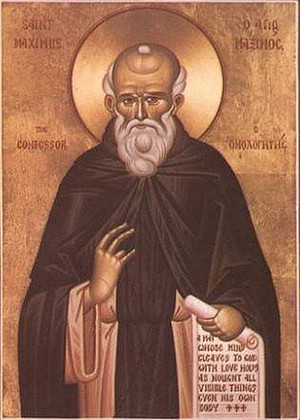Maximus the Confessor
Despite ambiguity concerning whether his birthplace was Palestine or Constantiople, it is clear that he fled to North Africa to avoid the invading Arabs and Persians. 613/4 entered monastery in Chrysopolis. 624/5 moved to monastery of st. George at Cyzicus. Only in 626 do we have concrete information because at that time he began to struggle against Monotheletism and Monergism. 628-630 arrives at Carthage (monastery of Eucratas). 633 possible stat at Alexandria. 634 Pact of union (Psephos) of Sergius supported by Pyrrhus in hope of reconceiling Monophysites. 638 Ekthesis (imperial decree) supporting Monothelitism. 638 he rejected the formulae that Christ was in two natures and one will. The Monergist controversy came to a head in 645 when M. publicly debated Pyrrhus, bishop of Constantinople, in Carthage. Pyrrhus was defeated and agreed to renounce his errors to the pope in Rome, upon which journey M. accompanied him. M. stayed there with Pope Martin and became an influential theologian with him. Against imperial orders, Martin summoned a synod in 649, which convened under the leadership of M. and roundly condemned the doctrines of Monothelitism and Monergism. The emperor responded by having Martin and M. arrested in 653. M. was condemned for high treason and in 655 he was exiled to Thrace. Summoned again to court in Constantinople in 662, M. failed to renounce his positions on Christology, and so suffered the punishment of having his tongue and right hand cut off, dying shortly after in exile in Lazica in Georgia. His ignominy did not last for long, however, since the Third Council of Constantinople endorsed his theology. He is venerated as a holy confessor for standing up for orthodoxy in the face of possible death.
Over 90 works of M.’s are extant in the genres of exegetical, mystagogical, epistles, ascetic, and dogmatic writings. Ambigua. Among his exegetical works are his 65 Quaestiones ad Thalassium (630–33) answering questions from a Lybian monk. 79 Quaestiones et dubia, exp. Ps. 59, or dom. His Mystagogia is based on the De ecclesiastica hierarchia of Dionysius the Areopagite and describes the whole cosmos as participating in worship of God. His letters provide both short treatises on doctrine and key historical information on his life and times. The Liber asceticus and Capita de caritate, which belong to his ascetic corpus, contain 400 mystical sentences (thoughts) from the church fathers. The Capita gnostica contains 200 sentences and bear the mark of Origen’s thought. M.’s dogmatic theology, unsurprisingly, focuses on Christology. Twenty-seven Opuscula theologica et polemica are against the Monophysites and Monoenergists and are remarkable for their conciseness. The De duabus unius Christi nostri voluntatibus and the Disputatio cum Pyrrho are contra the Monothelites.
M.’s Christology is defined in opposition to Monothelitism and Monergism. The qualities of willing and action belong to the nature of Christ. Therefore, Christ would not be true God and true man without two wills. In ethics, the human being must be rid of passions. The possibility of successfully warring against the passions is enabled only through the freely chosen death of Christ. His understanding of the human passions is largely influence by Evagrius Ponticus, while his cosmology derives from Pseudo-Dionysius. M. wrote commentaries on works by both of these fathers
He was the most important Greek thinker of the 7th century. Hans Urs von Balthasar found special inspiration from M., about whom there was a revived interest in the 20th century.
